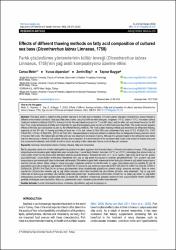Effects of different thawing methods on fatty acid composition of cultured sea bass (Dicentrarchus labrax Linnaeus, 1758)
Citation
METİN Cansu,ALPARSLAN Yunus,EKŞİ Zerrin,BAYGAR Taçnur Effects of different thawing methods on fatty acid composition of cultured sea bass (Dicentrarchus labrax Linnaeus, 1758). Su Ürünleri Dergisi 39, no.3 (2022): 206 - 214. 10.12714/egejfas.39.3.05Abstract
This study aimed to determine the potential changes in the fatty acid composition of frozen cultured sea bass (Dicentrarchus labrax) thawed at different environmental conditions. Sea bass fillets were thawed using four different methodologies: refrigerator (+4°C), water (+15°C), microwave (defrost mode) and ambient conditions (22±2°C). Some part of the fish was thawed once (on the 7th and 30th days), and the other part was thawed twice (on the 30th day). Thus, crude lipid analysis and fatty acid composition by gas chromatography were carried out in the thawed sea bass fillets. The results showed negative effects on the fatty acid composition caused by the different thawing methods. The most suitable thawing method was determined as refrigerator thawing, especially on the 30th day 1st thawing according to least loss of the lipid values (9.19±0.18%) and unsaturated fatty acids (C18:2 25.92±0.13%, C20:5 5.56±0.02%, C22:6n-3 8.90±0.09%, ∑PUFA 44.70±0.04%). Samples thawed in water and ambient conditions follow the refrigerator thawing method in terms of lipid and fatty acids. The highest lipid and fatty acid loss was observed in microwave thawing. Although the samples thawed in the refrigerator were better than the other groups in terms of lipid content and fatty acid composition, it is recommended to the consumers that frozen foods should be thawed only once and consumed immediately, and that fish should be frozen according to their needs and thaw as much as they can consume. Bu çalışmada, dondurma ve farklı ortam şartlarında çözündürme işlemi uygulanan kültür levrek balığının (Dicentrarchus labrax Linnaeus, 1758) yağ asidi kompozisyonunda meydana gelen değişimlerin tespiti amaçlanmıştır. Levrek balığı filetoları, buzdolabı (+4°C), su (+15°C), mikrodalga (buz çözme modu) ve ortam şartları (22±2°C)’nda olmak üzere dört farklı ortamda çözündürülmüştür. Balıkların bir kısmı bir (7. ve 30. günde), diğer kısmı ise iki kez (30. günde) çözündürülmüştür. Çözündürülen levrek balığı filetolarında ham yağ ve yağ asitleri kompozisyonu analizleri gerçekleştirilmiştir. Tüm grupların yağ asidi kompozisyonu gaz kromatografi cihazı kullanılarak belirlenmiştir. Elde edilen bulgular farklı ortamlarda birden fazla çözündürmenin yağ asitleri kompozisyonu üzerinde olumsuz etkilere sebep olduğunu ortaya koymuştur. Uygulanan çözündürme tekniklerinden en uygun çözündürme ortamının özellikle 30. gün ilk çözündürme günü ele alındığında yağ değerleri (%9,19±0,18) ve doymamış yağ asitleri sonuçlarında (C18:2 %25,92±0,13, C20:5 %5,56±0,02, C22:6n-3 %8,90±0,09, ∑PUFA %44,70±0,04) en az kayıp görülmesinden dolayı buzdolabında çözündürme yöntemi olduğu sonucuna varılmıştır. Suda ve ortam koşullarında çözündürülen örnekler yağ ve yağ asitleri sonuçları bakımından buzdolabında çözündürme yöntemini takip etmektedir. Yağ ve yağ asidi miktarında en fazla kayıp mikrodalga çözündürme yönteminde gözlenmiştir. Buzdolabında çözündürülen örnekler her ne kadar yağ miktarı ve yağ asitleri kompozisyonu açısından diğer gruplara göre daha iyi olsalar bile tüketicilere dondurulmuş gıdaların sadece bir kere çözündürülerek hemen tüketilmeleri gerektiği ve ihtiyaçları oranında balıkları dondurup, yiyebilecekleri kadar miktarları çözündürmeleri önerilmektedir.


















